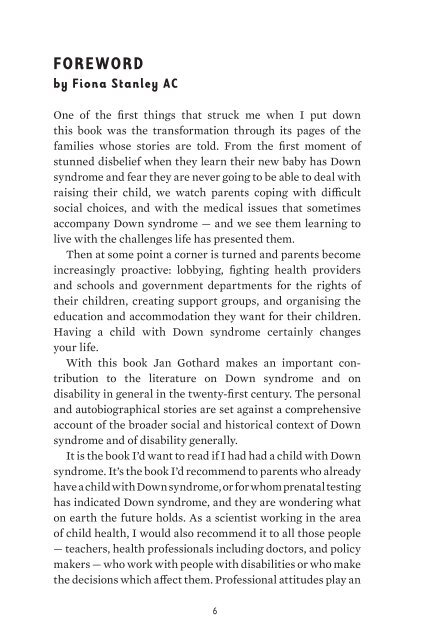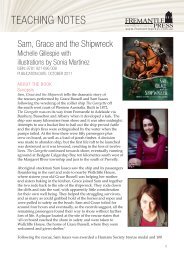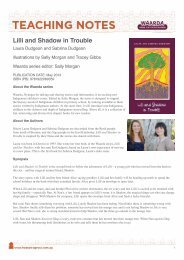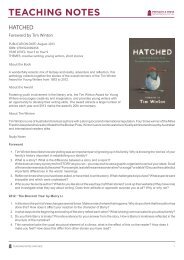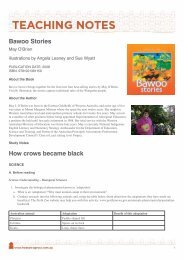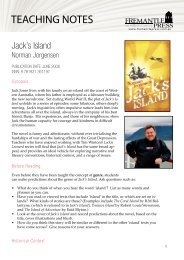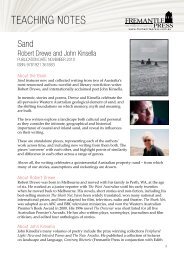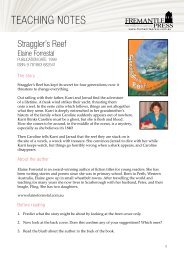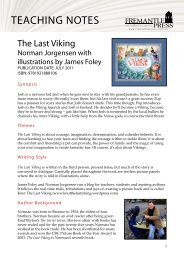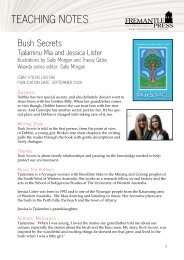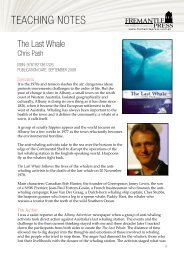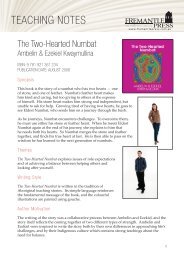Greater Expectations sample.pdf - Fremantle Press
Greater Expectations sample.pdf - Fremantle Press
Greater Expectations sample.pdf - Fremantle Press
You also want an ePaper? Increase the reach of your titles
YUMPU automatically turns print PDFs into web optimized ePapers that Google loves.
Forewordby Fiona Stanley ACOne of the first things that struck me when I put downthis book was the transformation through its pages of thefamilies whose stories are told. From the first moment ofstunned disbelief when they learn their new baby has Downsyndrome and fear they are never going to be able to deal withraising their child, we watch parents coping with difficultsocial choices, and with the medical issues that sometimesaccompany Down syndrome — and we see them learning tolive with the challenges life has presented them.Then at some point a corner is turned and parents becomeincreasingly proactive: lobbying, fighting health providersand schools and government departments for the rights oftheir children, creating support groups, and organising theeducation and accommodation they want for their children.Having a child with Down syndrome certainly changesyour life.With this book Jan Gothard makes an important contributionto the literature on Down syndrome and ondisability in general in the twenty-first century. The personaland autobiographical stories are set against a comprehensiveaccount of the broader social and historical context of Downsyndrome and of disability generally.It is the book I’d want to read if I had had a child with Downsyndrome. It’s the book I’d recommend to parents who alreadyhave a child with Down syndrome, or for whom prenatal testinghas indicated Down syndrome, and they are wondering whaton earth the future holds. As a scientist working in the areaof child health, I would also recommend it to all those people— teachers, health professionals including doctors, and policymakers — who work with people with disabilities or who makethe decisions which affect them. Professional attitudes play an6
enormous role in shaping the lives of people with disabilitiesand their families, and this book gives a privileged insight intothe impact of such decision-making, for better and worse, at apersonal level.What people need foremost is information. Reliableinformation. The more we know, the less foreign is the terrainand the better we can deal with the masses of misinformationthat still abound. And, just as important, we need to knowwe are not alone, that others have faced the decisions anddilemmas that we are now facing. That our responses are notabnormal. <strong>Greater</strong> <strong>Expectations</strong> provides all this and more. Itshows children, young people, men and women with Downsyndrome, ‘busy doing perfectly normal things, getting onwith their lives.’Some chapters will be confronting reading for any newparent, but the overriding feeling is deeply positive. In societyat large, enormous progress has been made in the last fewdecades. The period when parents were encouraged to givetheir children over to institutions, encouraged to believe thattheir child was beyond schooling and was unlikely to liveinto adulthood is over — very largely thanks to the ‘courageand stubborn persistence’ of an older generation of parents ofchildren with Down syndrome ‘driven by love or duty to offertheir children a better life.’That better life — with opportunities in education, sport,play and work that were hardly dreamt of a generation ago —is here now, but there is still quite a way to go. As Jan Gothardreminds us, ‘We owe all this to the parents who fought againstnegative expectations; we owe it to our children to keep ourexpectations growing.’ This book will surely feed thosegreater expectations.Professor Fiona Stanley AC, October 2010Patron, Down Syndrome Association of Western Australia7
IntroductionBorn in Western Australia in 1977, Christopher Derkacz hadDown syndrome. As sometimes happened to children likehim in the 1970s, his family relinquished him, he was made award of the state and put into care. In January 1979, when hewas just twenty-three months old, his foster mother took himto Perth’s Princess Margaret Hospital for Children, sufferingfrom croup. She thought she had left him in the best placeand the safest hands, but she was wrong. Christopher had afurther attack of croup that night but, instead of reviving him,the nursing staff left him to die, because the notes prepared byhis doctor were marked: ‘Not for resuscitation — no cardiacmassage or intubation.’ 1 At the inquest, the nurses who hadattended Christopher were advised not to give evidence, onthe grounds that it might incriminate them; but, accordingto both the press report and a subsequent question raised inthe Western Australian parliament, the doctor in charge ofthe case said that children like Christopher should not evenbe admitted into the hospital’s intensive care unit, and that ifthey lived they too often became a social burden.Australians are not the only people who have refusedappropriate medical treatment to people with disabilities likeDown syndrome. There have been celebrated cases in both theUnited States and the United Kingdom of individuals fighting,usually unsuccessfully, for the right even to go on a transplantwaiting list. After a much publicised campaign in the mid1990s, American woman Sandra Jensen finally received aheart and lung transplant, though she died from complications13
GREATER EXPECTATIONSsixteen months later. She was almost certainly the firstperson with Down syndrome, and may well be the only suchindividual to date, to have received a major organ transplant. 2But while progress has not always been straightforward, Ibelieve we have come a long way from that moment in January1979 when a toddler was refused life-saving treatment foran everyday childhood ailment like croup, because a doctordecided that a life with Down syndrome simply wasn’tworth living.This book is not about Christopher and Sandra, but it isabout people like them, and their families. It’s also about acommunity. From the day my daughter Madeleine was born in1992, I have been part of a community which stretches acrossstate and national boundaries, overriding language, race andethnicity. I have been approached by a Chinese-Americanfamily in the Te Papa museum in Wellington, New Zealandwho, after a few penetrating glances, wandered over to askhow my daughter was going. Two of my daughters were withme, but I had no doubt which one they meant. I have exchangedsmiles with a Korean couple in Cambodia, members of a tourgroup, as they and their adolescent son explored the Khmerruins at Angkor. My partner Charlie and I have been known tostare as we drive past an individual on the street, or when wespot a family on the beach or at a shopping centre — are theytoo part of our ‘community’? I once resisted the temptationto stalk a young woman wearing a staff uniform in a hospitalcorridor, intensely curious to know exactly how she wasemployed there and whether they had room for another one.We have been approached more than once in coffee shops andparks by parents and grandparents who have remarked on our‘lovely family’. We were out doing normal things, behaving inentirely usual and not always perfect ways, yet the phrase andcompliment are always loaded with meaning. The day before14
INTRODUCTIONmy daughter was born, these people would have remainedlargely invisible to me, and my family to them.‘Community’ can be purchased cheaply these days; for theprice of a car sticker, anyone can attest that they are friendsof the ABC or that their ‘other family’ is the East <strong>Fremantle</strong>Yacht Club. Members of what I think of as the Down syndromecommunity, and the disability community more generally,may share nothing more than a familiarity with disabilityand no doubt many would rather share less. For writer KathyEvans, the public recognition of her daughter’s ‘communitymembership’ was no ‘warm and fuzzy moment’.It served only as a reminder that my child was not just amember of my family, built from the atoms of generations ofCeltic ancestors, but part of a distinctly recognizable breed,like poodles or Siamese cats. 3Questions about what it means to have Down syndromein the family, how individuals and families experience thatsituation, and the social implications of living within that‘community’ are contentious. Brian Stratford, doyen ofthe Down syndrome world, has written glowingly of thecommunity in terms of parent organisations across the worldwhich contain within them otherwise warring parties, boundtogether by the common cause of improving the lot of theirkids. He writes of a variety of such bodies, including ‘Catholicsand protestants in Northern Ireland … work[ing] togethertowards the development of their children with Down’ssyndrome,’ the Indian Down syndrome association with itsmulti-religious membership, and the Zimbabwean associationcomprising ‘both black and white, taking into considerationonly the needs of their children and their support for eachother,’ and concludes that: ‘John Langdon Down has givenhis name not only to a single pathological condition causing15
GREATER EXPECTATIONSmental handicap, but to a worldwide community of peoplewith potential.’ 4 I am less sanguine than Stratford about thepotential for harmony within the Down syndrome community,but less defensive than Evans. This book explores what Iconsider to be the transcending experience of living withDown syndrome; but it does so in full recognition that, likemost communities, the differences within it may be as great asthe factors that create it.Once, a child with a difference was a child to be hidden ordenied, but since perhaps the 1950s, as institutionalisationof children with disabilities began to be questioned byprofessionals and, increasingly, by parents, so too writingabout a child with a physical or intellectual disability hasdeveloped into an autobiographical genre. One of the firstpeople to publish a book in English about their experienceswas singer/songwriter and actor Dale Evans. In 1950, she andher husband, renowned stage cowboy Roy Rogers, becamethe parents of Robin Elizabeth, who had Down syndrome andwho died just short of her second birthday. Angel Unawareis written in the voice of baby Robin, cast as an angel sent toearth to spread joy and awareness. The book, motivated by thecouple’s Christian beliefs, was published only with difficulty— it was not a popular topic at that time. However, as one ofthe earliest of such ‘true confessional’ works, the book gavehope to many who read it and has sold over a million copies. In2004 a fiftieth anniversary edition was published.Is it easier or harder for families of note to accept theirdifference? Anne de Gaulle was the daughter of GeneralCharles de Gaulle and his wife Yvonne. Born in 1928 with Downsyndrome, she was never separated from the rest of the familyand lived a fully included life, her acceptance and protectionpart of the family’s deeply held values. Her death in 1948left the general devastated. 5 On the other hand, playwright16
INTRODUCTIONArthur Miller’s son Daniel, born with Down syndrome in1966, was institutionalised at birth, despite the wishes ofthe boy’s mother, Inge Morath, who continued to visit himthroughout his life. Though Miller did not mention this sonin his autobiography, he was apparently reconciled with himlater in life when Daniel left the institution, and shortly beforethe playwright’s death, Miller bequeathed Daniel, along withhis siblings, an equal share of his assets. 6It took Pulitzer and Nobel Prize winning author Pearl S.Buck thirty years to publicly promote knowledge of her muchloveddaughter. Born in 1920, Carol was ‘mentally retarded’,institutionalised from adolescence and thereafter kept out ofthe public gaze. Buck’s book about Carol, The Child Who NeverGrew (1950), was re-published in 1992, and as the forewordnotes:For families whose lives were haunted by the sad mysteryof mental retardation, all the scientific explanations in theworld would not have as much impact as a famous, respectedperson disclosing publicly, ‘I speak as one who knows.’Perceptively, referring to the courage it took to self-revealin the 1950s, the foreword also refers to ‘the 1990s’ tell-allatmosphere of celebrities baring their most private scars.’Whereas having a child with a disability makes most people feeluncomfortably ‘different’, it somehow seems to give celebritiesa veneer of normality by showing that, just like the rest of us,the beautiful people too can experience life’s challenges. Forthat reason, the birth of a child with a disability is often anoccasion for the media to descend. Yet the publicity can alsobecome an important and uplifting focus for more ‘regular’families, and there is no doubt that giving disability morecurrency can serve valuable political ends, with disabilitysocieties around the world quick to acknowledge or seize the17
GREATER EXPECTATIONSpatronage of celebrities such as racing car driver Damon Hillor rock star Nik Kershaw, both of whom have a child withDown syndrome.The birth of Domenica Lawson in 1995 gave the Downsyndrome community in Britain a powerful public voicethrough her father Dominic Lawson, former long-timeeditor of the London Sunday Telegraph, and her mother RosaMonckton. Godmother Diana, Princess of Wales, addedfurther cachet to Domenica’s life, although we have not yetseen Domenica appear on television with kitchen goddessaunt Nigella Lawson. Since Domenica’s birth, her parents havebecome highly articulate and outspoken critics of policiessuch as the assumption of automatic termination of Downsyndrome pregnancies and both have written movingly abouttheir rather different responses to their daughter’s birth.Just as the death of the Princess of Wales raised awarenessabout wearing seatbelts and Kylie Minogue’s breast cancerled to a rise in mammograms, the well-publicised birth of achild with Down syndrome in a prominent family sends outa message that this can happen to anyone. While it may alsohave increased the incidence of prenatal screening, the birthof Domenica Lawson underlined the fact that having a childwith Down syndrome is not automatically such a bad thing.That is, after all, the message which permeates autobiographicalaccounts of living with a child with Downsyndrome. Books and TV series with titles such as Life GoesOn stress the continuities of existence after the arrival of achild with a difference. Michael Bérubé’s wonderful Life As WeKnow It is an example of this genre, with Bérubé’s son Jamieat the heart of the family, but alongside and taking up no moreand no less space than Jamie’s elder brother Nick. Nowadaystoo, there is a gratifying trend away from the beatificationapproach exemplified in Angel Unaware, which left many18
INTRODUCTIONparents of less than saintly children a little uncomfortable;although the autobiographical Expecting Adam — with itsblunt allusion to the supernatural guiding powers of the childwith Down syndrome, even in utero — is clearly part of thatolder tradition. Despite their differences, however, what allthese books reveal is that, as individuals, people have feltcompelled to talk about the profound impact of the birth of achild with disability. Their powerful need to articulate theirshock and reaction speaks volumes of the still-hidden natureof disability in society today.Until recently, intellectual disability was a relativelyunexplored theme in social and historical research in Australia,but over the past decade or so more has been writtenas disability has become an increasingly acknowledgeddimension of social difference. This book represents aconvergence of two streams of writing: personal andautobiographical parental accounts, and historical andcontemporary analysis of disability. It ranges over themesassociated with rites of passage and pivotal social momentsand discusses birth experience and the acceptance ofdisability; family and community support; health issues;education; growing up and finding work, and independentliving. All these themes are located within a broader socialand historical context. The book also looks at family decisionmaking:continuing or terminating pregnancies; acceptingor relinquishing children at birth, and learning how to letthem go. Where possible, these themes are explored from thepoint of view of individuals with Down syndrome, as well astheir families.This book is based on more than sixty personal interviewsrecorded across Western Australia but it has broadgeographical and social application beyond Australia, andcertainly reinforces an understanding of the universalising19
GREATER EXPECTATIONSaspects of some experiences of disability. Western Australia infact has much to offer as a place to locate a study such as thisbecause of the richness of the research already undertakeninto disability and Down syndrome in this state. The 1996edited collection Under Blue Skies: The Social Constructionof Intellectual Disability in Western Australia is a pioneeringhistory of intellectual disability in Western Australia andstill remains unmatched by publications in other Australianstates. Western Australia is also the home of the acclaimedTelethon Institute for Child Health Research whose directorProfessor Fiona Stanley is Patron of the Down SyndromeAssociation of Western Australia. The Telethon Institutehas been responsible for producing a huge body of researchdata on issues such as the health and longevity of people withDown syndrome and the impact of prenatal screening. It alsoproduced the Down Syndrome Needs Opinions Wishes StudyReport in 2007, which surveyed more than three hundredWestern Australian families living with Down syndrome.These and other publications have been used to complementthe personal accounts in the pages which follow.The people I interviewed were culturally and sociallydiverse and included Aboriginal and migrant families. Istarted interviewing more than a decade ago, which hasgiven me the unexpected opportunity to revisit some of theearliest informants, in what eventually became an unplannedlongitudinal study. 7 In the course of talking to people, it soonbecame apparent that the biggest factors determining one’sexperience of Down syndrome were place of residence —metropolitan or regional — and the era when an individualwith Down syndrome was born. Services undreamt of inregional settings were often delivered to the doorstep inmetropolitan Perth, while predictably, services waxedand waned and educational opportunities differed as state20
INTRODUCTIONgovernment policies shifted over time. More importantfor me than charting changes in policies and provision ofservices though, was finding out how people had respondedto the opportunities available and how the choices they madeaffected their lives.The majority of my interviews have been with parents,primarily mothers, and other carers of people with Downsyndrome, but about one-third of the people I interviewedhad Down syndrome. When I commenced interviewing, Iwanted to focus very much on the question of what it meantto have Down syndrome, and I approached this issue in thebroader context of finding out how young adults with Downsyndrome lived their lives. What I found was how very like, inmany ways, were the lives of the people I spoke to, comparedto those of their peers who did not have a disability. Rangingin age from sixteen to their thirties when I interviewed them,the majority of those young adults lived at home with theirparents. One young woman had taken out a mortgage andwas buying her own home, a unit she shared with a friendwho also had Down syndrome. Another man rented a unit in<strong>Fremantle</strong> where he lived by himself. One couple was marriedand living independently in a larger south-west town. Nonewas in any form of residential facility, and none had beeninstitutionalised at birth, which would have been more typicalof older people with Down syndrome. Social interaction,recreation, education and training, relationships, work andfamily were the main focus of their lives and, while some cleardifferences existed — largely associated with independence —my interviews reinforced Jan Walmsley’s observation that‘being a person with a learning disability is most akin to beinga human being.’ 8Sometimes documenting the normal can be difficult.The discrepancy between experiencing Down syndrome as21
GREATER EXPECTATIONS‘normality’, and living alongside it as a disability, is a profoundone and, in trying to present different understandings ofwhat it’s like living with Down syndrome, one that I neededto keep very much in mind. My own experience of disability,and the experiences related to me by the carers and parents Iinterviewed, confirmed for me that disability can profoundlyaffect one’s life. So while this book is based on optimismabout the future and an overwhelming belief that people withdisabilities such as Down syndrome can, should, and do leadnormal lives, it is underpinned by a historian’s awareness ofpast struggles to bring about change.A researcher’s position is never neutral, but I have feltparticularly challenged by this work. My interest in disabilityis precisely as old as my daughter. As she has grown up I havebecome increasingly aware of how an everyday life livedwith disability can be a political and social battleground,one of which my daughter still remains largely unawarebut one in which her parents engage on a daily basis. I haveexperienced disability as both oppressive and ‘disabling’ and,as an interviewer, I always kept that in mind. I have muchin common with many of the parents interviewed in termsof experiences associated with the recognition of a child’sdisability and working through the consequences, but manyparents do not share my view of disability as a condition madeworse by, but which could be made better by, social attitudes.This is a difficult line to tread but, as interviewer, I attemptedto render my personal views invisible in the interviewingsituation. My intention was, after all, to see how a range ofpeople experience living with a disability, not to proselytise orsee how many people shared my point of view. Clearly however,interviewing from within a community presents a numberof challenges. 9 The Down syndrome community in WesternAustralia is a reasonably small one and as an interviewer22
INTRODUCTIONI always identified myself as a parent of a child with Downsyndrome, believing that the informants’ awareness that I toohad ‘been there’, in fact still ‘was there’, could encourage thesharing of deeply-buried and sometimes painful memories. Itwas also a good starting point for interviews with people withDown syndrome too, explaining that I wanted to ask abouttheir lives and, incidentally, about having Down syndrome,because of my daughter.Equally challenging has been the question of how to use myown voice. I am an interviewer and researcher, but I too havea story to tell. The question of selecting interview extracts,locating them within the text, and above all, giving themweight, was a difficult one. The responsibility for interviewing,editing and writing was mine. However, in order to give myvoice what I hope is no more than equal weighting with otherparent voices, I primed a friend to interview me. Like all theother interviews in this book, that one too is used anonymously,and enables me to have ‘my’ voice heard directly. 10 I cannotdeny though that as editor I have had the opportunity to selectmaterial and to stage manage to produce effects which suit myown convictions. As historian Ann Curthoys has noted of asimilar challenge — writing a historical account of an episodein which she herself was a participant — ‘Even if I satisfymyself that I have avoided these traps, will others believethat I have?’ 11 I have to hope so. This book is not intended tofit into that autobiographical self-revelatory genre of booksabout how one family lives with disability; rather, it draws onmultiple voices to show the plurality of that experience.Interviewing people with an intellectual disabilityundoubtedly raises profound ethical questions for a researcher.As an interviewer and as someone who has been involved withdisability for many years, I am well aware of the tendencyidentified by Karen Hirsch of speaking on behalf of people with23
GREATER EXPECTATIONSdisabilities, especially, as in this case, intellectual disability,and I took on board her caution that ‘it is hard to overstatehow resistant and pervasive is the cultural assumption thatpeople with disabilities cannot speak for themselves.’ 12Among people with Down syndrome there are many whoare more than capable of doing so, of telling an interviewerabout the lives they lead, their experiences, interests andaspirations. More generally, in terms of self-expression, thereare books authored by people with Down syndrome, rangingfrom the classic 1967 publication Nigel Hunt’s The World ofNigel Hunt to Kingsley and Levitz’s Count Us In, now in itssecond edition in 2007. Australian actor and advocate RuthCromer and young American advocate Karen Gaffney areboth renowned speakers at international disability forums; inWestern Australia, Justin Marshall is a frequent speaker onthe topic of having Down syndrome. Such individuals, though,remain a tiny minority. While people with Down syndromeare not all similarly disabled, nor are they equally ‘able’. Somepeople with Down syndrome are simply not articulate and tointerview only those who could sustain a lucid conversationwould be to misrepresent the community. As Brian Stratfordobserves,it is distressing for parents of a good number of childrenwith Down’s syndrome to be constantly hearing of nearnormal development and of high individual achievementwhen their own child is not making anything like that kindof progress. 13On that basis, one of the dilemmas I faced in undertakingthis research project was balancing my desire to interviewthe most articulate people with Down syndrome I could find,with the recognition that other people’s stories, less clearlyverbalised and sometimes harder to render meaningful for24
GREATER EXPECTATIONSparents and far-sighted professionals, and of ideological shiftsin understandings about disability, we now understand andact on the belief that people with disabilities have a potentialwhich can be tapped and nurtured.The second theme is belonging and inclusion. Support isincreasingly there to assist people with disabilities to engagemore fully in the community but it’s still a journey down a onewaystreet. The state of full inclusion could be reached a lotmore quickly, and would appear a lot more attractive to thosewho are still wary of it, if the rest of the community wouldmeet people with disabilities halfway. Inclusion means morethan simply having people with disabilities in mainstreamclassrooms and workplaces. It’s about a state of mind whichsees people with disabilities accepted as valued, significantand worthwhile members of society: people who have everyright to belong. Though we have travelled light years in thepast few decades, the absence of this mindset is unfortunatelystill evident in Australian society today, in places as far apartas maternity wards and the government’s department ofimmigration.Above all though I have kept in mind the profoundchanges that have occurred in the lives of people with Downsyndrome, which make the story of Christopher Derkacz soconfronting to us today. Consider people like Yolanda, Stefanand Judith, Nick, and countless others. Yolanda Berg is amember of the Western Australian government’s MinisterialAdvisory Council on Disability, contributing the criticallyimportant perspective of people living with intellectualdisabilities to that forum. Linda Katuna Rich has workedwith Coles Supermarkets since 1997, while Nick Cartmel hasbeen employed at what is now the Western Australian stategovernment’s Disability Services Commission since 1992.Judith Mincham and Stefan Zwickl, who both have Down26
INTRODUCTIONsyndrome, got married in 2009. Samala Ghosh has won aprize for art in an open competition. Tom Softly flies with hisfather in a small plane and has medals for motorbike trials.Since 2007, Stephen Donovan has broken twelve world Downsyndrome swimming records. Patrick Ricciardo has competedin the Rottnest Island swim. Julia Hales performed in herown show, Soapy Dreaming, in an acclaimed Solo Spot dramafestival in 2008. Whether it’s learning to read and write, ride abike, catch a bus, hold down a job or, like Karen Gaffney, swimthe English Channel, people with Down syndrome are doingit. Fifty years ago, they weren’t. We owe all this to the parentswho fought against negative expectations; we owe it to ourchildren to keep our expectations growing.Finally, I want to start this book by recalling my partnerCharlie’s words about our daughter Maddie.When she turned one, we all got round to celebrate herbirthday and thought back to the day she was born, all thetears, all the trauma, and I just couldn’t help thinking, whaton earth was all the fuss about?27
chapter 1‘The baby I’d dreamed of having’‘I remember one of the nurses coming in and saying, “Wellyou’re lucky she wasn’t born thirty years ago, because shewould have been put away and what have you. She’ll go toschool and she’ll learn to read.” I was lying there thinking,yes, but she was going to be a brain surgeon.’(Heather Burton)In 1990, two years before my daughter Madeleine was born,Fay Weldon’s book Darcy’s Utopia was published.I think about my friend Erin as I often do. She has a Down’ssyndrome baby. We all knew it would be disastrous; weforetold that her husband would walk out, that her otherchildren would suffer: we saw she was the only one of thefamily unit who couldn’t bear not to see the fruit of herwomb, however sour, ripen, drop and live. And that’s how28
1. ‘The baby I’d dreamed of having’it turned out: the child, now twelve, is badly retarded. Erinis no more than its nurse; she manages without a husband,her other children are spiteful and embarrassed. Erin talksabout the joy the mindless child brings her — well, so it may,but her love for it has been most destructive for others. Leftto us, friends and family, we would have said no, Erin, sorry,not for you. This baby you insist on having keeps otherbabies out, ones which won’t cause this distress to you andyours. Just not this one; Erin, try again. 15Images of the person with Down syndrome, mostlyunattractive, have always been present in our literature.Benjamin Compson, Faulkner’s shuffling idiot narrator inThe Sound and the Fury, is based on a character with Downsyndrome, and it’s not hard to find similar examples — thesad-eyed Mongol in Take Me to Paris Johnny and the ‘retardedMongol brother’ with the mismatched ears in The Jane AustenBook Club are just two. As every parent of a child with Downsyndrome is told though, ‘Of course, things are so much betternow!’ The Memory Keeper’s Daughter, an enormously popularrecent novel which focuses on a baby with Down syndromerelinquished at birth, is light years away from Darcy’s Utopia.Today, for those who look, there are many positivedepictions of people with Down syndrome in circulation inAustralia: television programs such as the memorable SBSseries House Gang, for example, which featured a group houseoccupied by people with intellectual disabilities, and the USTV series Life Goes On, starring Chris Burke. Pascal Duquennewas the Cannes award-winning star of the 1996 Belgian movieThe Eighth Day and in 2009, the Spanish actor with Downsyndrome Pablo Pineda was awarded the prize for best actorfor his role in the movie Me Too. In the United Kingdom thefabulous ‘docu-soap’ The Specials, filmed in a household of29
GREATER EXPECTATIONSyoung people with disabilities including Down syndrome, isgreat viewing.Like the concurrent process of ‘mainstreaming’ Indigenousand ethnic Australians in the media, people with disabilitiessuch as Down syndrome are starting to become more visibleas pleasant, even popular incidental characters in mainstreamproductions. The former Australian television series GP featuredthe engaging Tracie Sammut as a regular cast member;EastEnders now features a baby with Down syndrome, andAustralian actor Danny Alsabbagh appeared as Toby in therecent ABC TV series Summer Heights High. People withDown syndrome have appeared in Target catalogues and inadvertising for ABC TV. In 2009 the short film Be My Brother,about a young man with Down syndrome, carried off firstprize at Tropfest in Sydney for director Genevieve Clay whilethe lead actor Gerard O’Dwyer (who has Down syndrome)won the award for best actor.Clearly, disability is now viewed more positively than wasthe case just a generation ago. Yet the birth of a child with Downsyndrome still causes immense grief and untold anxiety for thefamily involved. The US term ‘retard’ has replaced the term‘spaz’ (a favourite when I was a teenager) as a contemporaryterm of abuse among younger people. In Australia in May2008, the Seven network’s television series All Saints featureda young couple — brother and sister — who were expectinga child, and who were told that because the relationshipwas incestuous, the baby would have Down syndrome. Thecontinuing currency of these sorts of images and this type ofextraordinary misinformation makes a family’s immediateresponse to the news that their child has Down syndrome andan intellectual disability at best ambivalent.Tied up with the anticipated arrival of a baby is theexpectation that the child will bring joy and happiness to the30
1. ‘The baby I’d dreamed of having’parents. Implicitly, a child is often seen as an extension ofone’s family, a link with both past and future. Most parents,particularly during their first experience of parenthood,marvel at the perfection which is their new child, andthere can be few who have not harboured secret dreamsand expectations. If we don’t necessarily yearn to parentprime ministers and brain surgeons, most of us hope at thevery least for the health, happiness and, ultimately, futureindependence of our offspring. At first glance, the birth of achild with Down syndrome seems to dash each one of theseaspirations.In not so distant days, the diagnosis of Down syndromewas so awful that parents were told to abandon all hope fora normal life with or for that child and to pass their Mongolbaby straight into the hands of an institution. The legacyof that process of systematic abandonment is still with ustoday. If Down syndrome is a condition we can test for andscreen against; if carrying a baby with Down syndrome isunquestioned grounds for termination; if bringing up a childwith Down syndrome was once considered so dreadful a fatethat people ‘put their child away’ instead, then the message isvery clear: such a child is something to guard against, not towelcome. What kind of future are we opting for if we acceptthis child into our home? It is this question in all its starknesswhich parents have to confront when they learn the newsabout their newborn child.Almost all parents of a child with Down syndrome rememberthe birth and the subsequent diagnosis in extraordinarydetail as one of life’s most profound watershed moments. Thememories are fixed, a mental video to be painfully replayedover and over again. First-time parent Britt Canning’s sonJack was born in 1995 at a hospital in Perth’s northern suburbs.Britt described receiving the news as ‘a huge shock, probably31
GREATER EXPECTATIONSthe biggest shock I have ever had and maybe ever will have,touch wood.’ She and her husband were left ‘quite shattered,absolutely devastated.’Looking back now, it was kind of bitter-sweet, it wasboth the worst and the best day of my life. It was quite atextbook labour, nine hours and no problems; he was bornnormally, naturally. He was a big baby too, a good size. I justremember once he was born I was in heaven, I was totallyecstatic. He breastfed straight away, he got an eight andthen a nine in the APGAR 16 test and he was obviously justthriving.At about nine o’clock, the paediatrician came in to see me.Jack was lying in a bassinet at the time, I was sitting onthe side of the bed feeling great, feeling really good. Thepaediatrician picked Jack up and put him in my arms andthen he said to me, ‘Have you heard of a condition calledDown syndrome?’ and my world just fell apart, just like that,those words. We were just absolutely shocked. I was holdingJack but I felt numb, completely numb. Now I wonder if itwas such a good idea to give him to me, it is amazing I didn’tactually drop him on the spot.Luke Middleton recalled similar sensations.I felt absolutely devastated. I remember going outside andsitting on a park bench at the front of the hospital andeverything seemed black and dark. I remember thinkingthat this was a terrible tragedy, a really terrible tragedy, andthat all my wishes had collapsed.Shock, horror and outrage went hand in hand with feelingsof numbness, denial and total disbelief, all underpinned by a32
1. ‘The baby I’d dreamed of having’profound sense of sorrow and loss: loss of the perfect childwhose arrival had been so eagerly anticipated, and loss of away of life that had been taken for granted. Talking of thismoment, people spoke in terms of their world falling apart,the end of life as they knew it; of devastation, anguish andmourning. For many parents, the death of their newborn childcould scarcely have been worse and, initially at least, one ofthe most common sensations was of bereavement.Recognition by medical staff that a child has Downsyndrome is usually almost immediate. The condition ismarked by a cluster of certain features which togetherconstitute the ‘syndrome’ identified by John Langdon Downin 1866. While most of the public can identify people withDown syndrome from the distinctive appearance of theireyes, not all people with Down syndrome share this featureto the same extent, and this is not the feature medical staffrely on for immediate identification. The classical features (or‘stigmata’, the technical term) of Down syndrome are visiblein the face, neck, feet and hands. The eyes may appear to tiltupwards and be almond-shaped, a fact which led to earliernaming of the syndrome as ‘Mongolism’, as this feature wasviewed as typically ‘Asiatic’. The irises, particularly in fairchildren, sometimes exhibit rather attractive light fleckscalled ‘Brushfield spots’. In some children, the tongue canprotrude a little, and the mouth and its cavity may be smallerthan normal. Ears too are sometimes smaller and the tipsslightly folded over. A child’s face sometimes appears flatter,especially the bridge of the nose, and the head smaller.Some children with Down syndrome have a characteristictransverse palmar or ‘simian’ crease, a single line crossingthe palm of the hand instead of two; others have an inwardcurved little finger. Sometimes a wide gap exists betweenthe first and the second toe. 1733
GREATER EXPECTATIONSLow muscle tone (hypotonia), which gives the newbornchild with Down syndrome its characteristic floppiness, isgenerally one of the first signs alerting medical staff to thepresence of the condition. Some of the ‘stigmata’, particularlythe smaller facial features, have medical implications, buthypotonia is the most significant as it can impact on the rate ofa child’s physical development. For that reason, while Downsyndrome is typically thought of as an intellectual disability,it is also accompanied by delayed physical development inmacro areas such as standing and walking, and in micro skillssuch as grasping and picking up objects. Low facial and oralmuscle tone, often responsible for a protruding tongue, canalso compromise or delay the child’s ability to take solid foodor to speak clearly.As most recent books on Down syndrome are quick to pointout, there is no correlation between the number of characteristicphysical features a person with Down syndrome has, and theirintellectual capacity. While that may be comforting later on,the knowledge that one has a child who can be identified as‘different’ from the moment of birth is not.Once the visible physical features have been noted, amedical practitioner will usually inform the family that Downsyndrome is suspected, and that this can only be confirmed bya blood test. Usually the child and both parents are tested, toconfirm the clinical diagnosis and to determine whether, asoccurs in a very few cases, either of the parents is a ‘carrier’. Butgenerally the blood test will not answer the pressing question— why us? Apart from the knowledge that the incidence ofDown syndrome does increase with maternal age, there is stillno explanation for its occurrence.A blood test, or cytogenetics report, clarifies the type ofDown syndrome which the child has. Ninety-five per centof cases occur in the form of trisomy 21, in which every 21stchromosome forms in triplicate instead of the usual twin34
1. ‘The baby I’d dreamed of having’form. Trisomy 21 has no apparent genetic implications. It isnot ‘carried’ or passed from one generation to the next, andto date there is no explanation for this aberrant chromosomalformation. We do know that it occurs naturally in all cultures,though the rate varies according to the age profile of childbearingwomen. In Western Australia, Down syndrome occursin about one in 445 pregnancies. 18Down syndrome also occurs in two other forms: mosaicand translocation. Mosaicism occurs when not all of thebody’s cells are trisomic: some cells are normal and some havea third 21st chromosome, distributed in a random or ‘mosaic’fashion. This condition has been described as ‘incomplete’ or‘partial’ Down syndrome, and occurs in about four per centof the population with Down syndrome. The condition is thesubject of some research and debate because the extent andimpact of the disability may be less than for other forms ofDown syndrome. 19 Swimmers with mosaic Down syndrome,for example, compete for records in a separate category fromswimmers with trisomy 21 as their performances are notalways comparable. Sometimes too the condition may takelonger to be identified, as was the case with Graham King inGeraldton whose mosaic Down syndrome was not diagnoseduntil he was five years old. 20Translocation Down syndrome, the least common formof all, is a condition where the extra 21st chromosome isnot attached to the twin 21st chromosomes, but to anotherchromosome. This seems to be of no additional significancefor the child, whose development and appearance will be‘typical’ of children with trisomy 21, but it can sometimes haveimplication for the parents, as this form of Down syndromemay occur where one of the parents themselves has sometranslocated genetic material. 21 This is not always the casehowever, as Trish Weston was well aware.35
GREATER EXPECTATIONSWill has translocation Down syndrome, and it caused usmassive angst waiting for our chromosome tests, to seewhich one of us was a carrier (the paediatrician had saidone of us ‘must be’). Will was the first grandchild on bothsides and the implications for our siblings and their futurechildren also seemed to be in the balance. It turned out thatneither of us was a carrier.The few days between initial diagnosis and confirmationby blood test are often days of great anxiety and roller-coasteremotions. These days, doctors tend to communicate theirbelief that the child has Down syndrome soon after the clinicalexamination, although this may also vary according to hospitalpolicy or the doctor’s inclination. When Catherine Slater’s daughterKaren was born in May 1979, the London hospital where shewas born had a policy of delaying passing on the news.If there was anything wrong, they wouldn’t tell you for fivedays, for fear the mother might reject the baby. So everyoneknew, but no one was telling me. I had absolutely no idea.I noticed nothing different from my first daughter; all youknew in those days about Down’s syndrome was photos ofpeople with pudding-bowl haircuts.When the news finally did come,It was terrible. We’d had all the congratulatory cards fromour friends and our family and everything. I couldn’t ringanyone to tell them. I just couldn’t. 22More recently in Perth, one family was denied knowledgeof the clinical diagnosis even though trisomy 21 had beenmentioned in the hospital case notes. The family was alreadyvery familiar with the condition as it had three adoptedmembers with Down syndrome.36
1. ‘The baby I’d dreamed of having’The doctors hadn’t told them what their suspicions were.They were simply saying, we need to do some tests andRobert had read the file and because of our family, as soonas he saw trisomy 21 he thought, hang on, I know what thatis. It was probably a week before the doctors in the hospitalwere prepared to even suggest that this child might haveDown syndrome. They were just playing the game, ‘We haveto wait till this blood test comes back.’ (Helen Golding)Certainly, once they have informed the parents, doctorsgenerally play down any possibility that their initial diagnosismight prove incorrect. Our doctor, for example, pointed outthat if our daughter didn’t have Down syndrome, she clearlyhad something else ‘wrong’ with her. Nonetheless, parentsinvariably hope against hope that there has been a mistake.Yet it is generally the initial news of the possibility of Downsyndrome rather than confirmation by blood test which isremembered most clearly and most shockingly as the momentwhen the world fell apart.What is the best way to break such news? Most parents feltthat they should have been informed as soon as there was anydiagnosis made by medical staff. But often it was the way inwhich the news was conveyed as much as the timing whichcompounded the distress, as was the case after Karen Langleyand Paolo da Silva’s daughter was born.The paediatrician arrived and examined Shannon and thensaid, ‘There is a heart murmur, but I don’t know how seriousit is at this stage.’ And then he said, ‘But I have to tell you Ihave concerns about your baby. I think this may be a Downsbaby.’ We were on the hospital bed and I think the mainmidwife from the Birthing Centre was there as well, andprobably the others were all hovering in the background.Paolo said something like, ‘What are you saying? Does37
GREATER EXPECTATIONSshe, or doesn’t she?’ Because the way he’d put it suggestedthat she might have; and then he said something whichconfirmed it. At that point, Paolo burst into tears.For Loretta Muller, bad as the news was, she believed it hadbeen well handled.Initially the nursing staff said that they had some concernsbecause Cameron was born a little bit blue, and so theywere talking about that rather than anything else. Theyweren’t saying anything. Although later the midwife camedown and said she knew as soon as he was born. But I didn’tnotice — I didn’t know anything about babies! And then thepaediatrician wanted to talk to me and my husband and sothey took us aside and explained what they thought. He hadseveral signs that suggested he may have Down syndrome,and as for everything else, he was fine. I thought it wasreally well done. It was without any prejudice. I never gotthe ‘I’m sorry to tell you’ or any of that. It was just, ‘Look,we think this child has Down syndrome.’ That was fine.‘We’ll do some tests and we’ll see what happens.’ I was veryshocked but I just thought, ‘Poor little bugger.’ Really, Ithought, we’ll just wait and see what happens.When William Mann went to the hospital to see his wifeMuriel on the afternoon of their son’s birth in 1967, he wasushered into a little nurse’s pantry off the ward where theirdoctor and an attendant paediatrician informed him that thechild had ‘Mongolism’ and then left William to explain thiscondition and its consequences to his wife. He hadn’t even seenthe baby. Even worse was the experience of Mavis Simpson in1943, who did not receive the news until well after she hadtaken her son Trevor home.38
1. ‘The baby I’d dreamed of having’When I went back to the doctor — after you come homefrom hospital, you go back after a short period — then thedoctor told me. It was a lady doctor and she was a very niceperson. But, of course, it was a shock to us.The different spheres of responsibility of doctors and nursesalso determine when the news is passed on. In quite a numberof cases, parents had to wait till the appropriate medical staffwere present. When Shannon was born in Canberra, hermother Karen had no idea of her disability until thirty-sixhours or so after she was born.She happened to be born in the early hours of Sunday morning,when there wasn’t a paediatrician available, who wasthe only person authorised to tell us. So the midwives knewand the doctor who delivered her knew, but nobody couldactually tell us, which at the time upset me enormously ...Almost instantaneously, when Shannon was born, themidwife who had been there all through my labour andthe birth sort of closed up and she just wasn’t the personthat she had been before. And she actually came to mea day later and apologised that she hadn’t been able tohandle it. She saw the baby had Down syndrome. She knewshe wasn’t allowed to say anything and she just couldn’trelate to the whole situation. But it was strange, that I hadnoticed the difference in her and there was actually goodreason for it.As a former nurse Trish Weston was well aware of thedifficulties faced by staff having to withhold information,particularly when it is evident the parents are activelyconcerned about the child’s condition.39
GREATER EXPECTATIONSThe nursing staff were particularly supportive once theyknew that I knew. Before that though, they really weretiptoeing around the edges, unable to say anything andfeeling very uncomfortable about it. I mean, you can justsense that happening all around you. I think it was activelydiscussed, I’ve gathered that everyone kind of knew, butthings weren’t really allowed to be said.Everyone knew the news was bad, but what it actually meantbeyond that was seldom clear. Most fears about the future werebased on understandable ignorance and in retrospect, someparents were even able to scoff at their own and their family’sresponses. Pamela Franklin recalled with laughter how,immediately after she had received her daughter’s diagnosis,her first thought was, ‘How am I going to go shopping withthis kid?’I thought people would look at me and look at her andthat sort of thing. I don’t know why it was shopping, it isnot as though I really love going shopping or anything, Idon’t know why I thought that but I did. And my motherin-lawthought, how was she going to tell the bowlingladies?After his daughter was born in 1995, Nigel Lawson wroteof his grief ‘at the thought that Domenica’s life expectancy isnot much more than half her elder sister’s.’ 23 The belief thatpeople with Down syndrome still have a much shorter lifeexpectancy than the rest of the population is incorrect, butthese and other sorts of misapprehensions about their child’sfuture all contribute to the despair which usually follows adiagnosis of Down syndrome. Most parents felt they had lostany chance of a normal life for themselves and their families.Later on, the feeling that life could remain normal — whatever40
1. ‘The baby I’d dreamed of having’‘normal’ might mean in the context of welcoming any newbaby into one’s household — became a source of great comfort.Yet it was the apparent certainty that a life shared with a childwith a disability would always be different that most disturbedHelen Golding when her first grandson was born. She herselfhad three adopted children with Down syndrome, but shedescribed her feelings when her eldest son Robert (who didnot have Down syndrome) had a child with Down syndromein 1992, in terms of deep shock.I was very upset. I was distressed because I knew that itmeant that their life was not what they had thought it wasgoing to be. Not because he is disabled, that doesn’t matter adamn. But because I knew that from that day onward theirlife was not going to be the road they had thought it wasgoing to be.None of these families had had any idea of the news awaitingthem. Kathy Evans in Tuesday’s Child talks of her horrorpregnancy with her daughter Caoimhe, and notes, ‘Later Idiscovered that mothers carrying babies with chromosomalabnormalities can be sick the entire length of the pregnancy.’But this doesn’t correlate with the experience of any of thewomen I interviewed, many of whom recalled that thepregnancy with the child with Down syndrome had been‘their best,’ a model. At least two, however, did recall a ‘fey’moment during the pregnancy, perhaps amounting to littlemore than what many mothers experience awaiting the birthof a child, especially their first. Britt Canning had recordedthe moment in her diary.Towards the end of my pregnancy with Jack, I wrote inmy journal that this has been the perfect pregnancy, nosickness, feeling wonderful, feeling better than ever, I hope41
GREATER EXPECTATIONSI am not being set up for a fall. I read that a couple of monthslater and it just gave me goose bumps, and it is almost like Idid have a little premonition, and I mentioned it in a couplemore entries towards the end, ‘I just hope this isn’t settingme up.’Karen Langley recalled a similar experience.There’s two things I remembered about the pregnancyafterwards in relation to the Down syndrome. When we hadour scan, I said to the woman who did it, ‘Oh, and there’sno sign of Down syndrome or something like that?’ almostlike a joke. And I remember her shaking her head, but in asort of thoughtful way, and not actually saying no, and it’shaunted me ever since that maybe she saw something anddidn’t feel like saying it or wasn’t able to say it or whatever.The other thing is, our family doctor — I must have talkedto her about the possibility of various difficulties and Iremember her clearly, she said, ‘I would put money on thefact that this baby will be normal.’ I went back and told herafter Shannon was born that she had said that to me, andshe sort of looked at the sky and said, ‘Oh, did I?’The birth of a child with a difference can have the effectof making one feel totally isolated, underlining the feelingthat one has been specially singled out. This was particularlythe case for younger women who had a baby with Downsyndrome. The ‘why me?’ element was foremost in manywomen’s thoughts in the early days after the birth and wasoften reinforced by comments from friends and family. Britt,in her mid twenties when her first son was born, was struckby people’s assumption that she was somehow responsible forher son’s condition.42
1. ‘The baby I’d dreamed of having’I didn’t feel guilty myself — I felt more that other peopleassumed my guilt. No, I absolved myself pretty early on,but a relative wrote to me actually saying that you must feelterribly guilty about it as well. And I remember thinking,‘Well, I don’t actually.’ And still to this day when I thinkabout that man, I feel like writing back to him and saying,‘You know, it wasn’t necessarily me.’One of the coping strategies sometimes adopted by parentsof children with disabilities such as Down syndrome, andexemplified in Dale Evans’ 1953 book Angel Unaware, wasto label their children as ‘gifts from God’ given only tospecial parents ‘chosen’ for their capacity to cope, but thatattitude certainly seems less common these days. None ofthe parents I interviewed saw themselves or their children inthis light.I was angry and I suppose I was angry in a religious sense. Ithought, ‘How dare God do this to me, I have tried to do theright thing by Him.’ But I got all that over with, out of theway and just got on with it. (Pamela Franklin)The belief that children with Down syndrome are onlyborn to older mothers remains widespread and indeed, somefamily and friends seem to think that if a woman had a childwith Down syndrome then it was her own fault for not takingproper precautions. When Luke Middleton rang his sisterwith the news, her first response was, ‘Didn’t she have thetest?’ Given the prevalence of the view that maternal agewas the cause, younger women felt particularly called uponto account for their child’s disability. In the absence of years,they surely must have had some other hidden flaw. At thevery least, they usually felt they had been particularly harddone by.43
GREATER EXPECTATIONSThen there was the older mother bit too — that was alsohard for people to understand. They said, ‘Why has thishappened to you? It shouldn’t have happened to you!’ andI felt that too! But yes, that was one of my first reactions:why did this happen to me? Then I looked at the odds of ithappening, and I thought, oh great! (Britt Canning)Maternal age is certainly a factor, with women overthirty-five more likely than younger women to have a childwith Down syndrome. However, most children with Downsyndrome are born to younger women simply because so manymore women below thirty-five have children and, until veryrecently, fewer had prenatal screening for conditions such asDown syndrome.Most people want to know why this has happened to them,and in the absence of any clear-cut answers, many look attheir own lifestyles and prenatal experience. Trish Westonhad worked many years in a hospital.Had I been exposed to too many X-rays when I was workingin the emergency department and those sorts of things? Iworked in theatre for quite a long time, and the gases thereare known to cause birth defects. I mean, that had been tenyears before anyway, but I guess I was just searching for areason why this had happened. I felt somewhat resentfulof other people I knew whose babies were just fine, despitethe fact that they smoked and drank through pregnancyand I’d done all the right things. I guess I felt like there wasno justice really!Scientist William Mann actively sought explanations whenhis son Geoffrey was born in 1967.The librarian at the biological sciences library got booksfor me, everything that she could find on Down syndrome44
1. ‘The baby I’d dreamed of having’and at that stage, it was still regarded as being a maternalcause. There was a lot of rubbish written about Downsyndrome. The book which reported the French discoveriesspoke of things in genetic terms, and I could understandthat, so it made sense. 24 But the best book that I read atthe time was Down’s original book. 25 It was really veryinformative.Whether or not it helps parents to be able to point a fingerand say, ‘That might have been the trigger,’ there remains noexplanation for Down syndrome.Getting a straight diagnosis can be complicated by thechild’s ethnic origins. In cases where the family had anAsian or non–Anglo Celtic background, aspects to the child’sappearance which might otherwise have alerted a doctor toconsider the possibility of Down syndrome were sometimesoverlooked, as Brenda Harvey discovered when her daughterGrace was born in 1992.I didn’t know Grace had Down syndrome until five days aftershe was born. Looking at her, you couldn’t tell. Because theyhave an Indian father, my girls have always had that Asianlook to them. And then the worst part was the waiting, fivedays of waiting, and not really knowing what I was waitingfor. And I asked our doctor what did he think, and he lookedat Grace and said, ‘Well, she has some of the features but notall of them, so it’s possible that she is Down syndrome butprobably not.’ Anyway, on the fifth day we had the resultsand my doctor came and told me that she did have it and soeven though it was half expected, it was still a shock.Claudia Mansour, who was originally from Lebanon, hadto wait a great deal longer for the truth when her daughterTheresa was born in 1976.45


